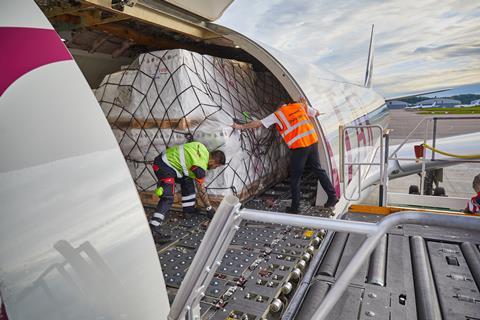July was another solid month for the air cargo industry, but rising Covid numbers could disrupt the sector’s recovery, according to IATA.
The latest numbers from the airline association show that in July demand in cargo tonne kilometre (CTK) terms increased by 8.6% compared with the same month in 2019 (used to mitigate 2020 Covid distortions).
Meanwhile, capacity in available CTK in July was down by 10.3% compared with 2019 levels. As a result of demand outpacing capacity, the cargo load factor reached 54.4% – a 9.5 percentage point increase on July 2019.
However, IATA director general Willie Walsh sounded a note of caution due to recent increases in Covid numbers as the Delta variant of the virus continues to result in lockdowns.
“July was another solid month for global air cargo demand. Economic conditions indicate that the strong growth trend will continue into the peak year-end demand period,” he says.
“The Delta variant of Covid-19 could bring some risks. If supply chains and production lines are disrupted, there is potential for a knock-on effect for air cargo shipments.”

IATA also points out that the pace of growth slowed in July compared with the 9.2% demand increase registered in June.
However, “economic conditions continue to support air cargo growth”, IATA said, pointing out that the July export orders component of the manufacturing Purchasing Managers Indices (PMIs) was 52.7%, indicating a short-term boost to demand if those orders are shipped by air and the inventory-to-sales ratio remains low ahead of the peak year-end retail season.
Typically, low inventories result in an increased use of air cargo in order to get stock to market as quickly as possible.
“Despite the near-term challenges, the upshot is that standard drivers of air cargo – notably those that contribute to the overall performance of air compared to other modes – remain supportive,” IATA said.
All regions registered an increase in demand, apart from Latin America.
Asia Pacific carriers saw CTKs increase by 1.2% in July compared with the same month in 2019. Load factors for the month stood at 65.4%, up 13.6 percentage points on two years earlier.
“Demand is being affected by an easing of momentum in key activity indicators in Asia, and by congested supply chains,” IATA said.
European carriers saw cargo traffic for the month increase by 6.1% on 2019 and load factors stood at 59.8% – an increase of 11.3 percentage points.
Although this was a slight slip on a month earlier, IATA said that manufacturing activity, orders and supplier delivery times are still favourable to air cargo.
North American carriers saw demand in July increase by 21.2% on two years earlier and load factors increased to 44.3%, up 7.1 percentage points.
This traffic increase was the strongest of all regions and comes as new export orders and demand for faster shipping times are underpinning performance.
Airlines based in the Middle East saw demand increase by 11.3% against 2019 and load factors stood at 53.6%.
Latin America-based carriers saw their cargo traffic for the month fall by 9.8% against 2019 and load factors were at 38.7%, up by 3.4 percentage points on 2019.
IATA said that performance from the region had been volatile but added that “several trade routes to/from Latin America are performing well, such as North-Central and North-South America and Europe-South America”.
African carriers’ statistics were unavailable at the time of release.
Damian Brett is the editor of Air Cargo News


























